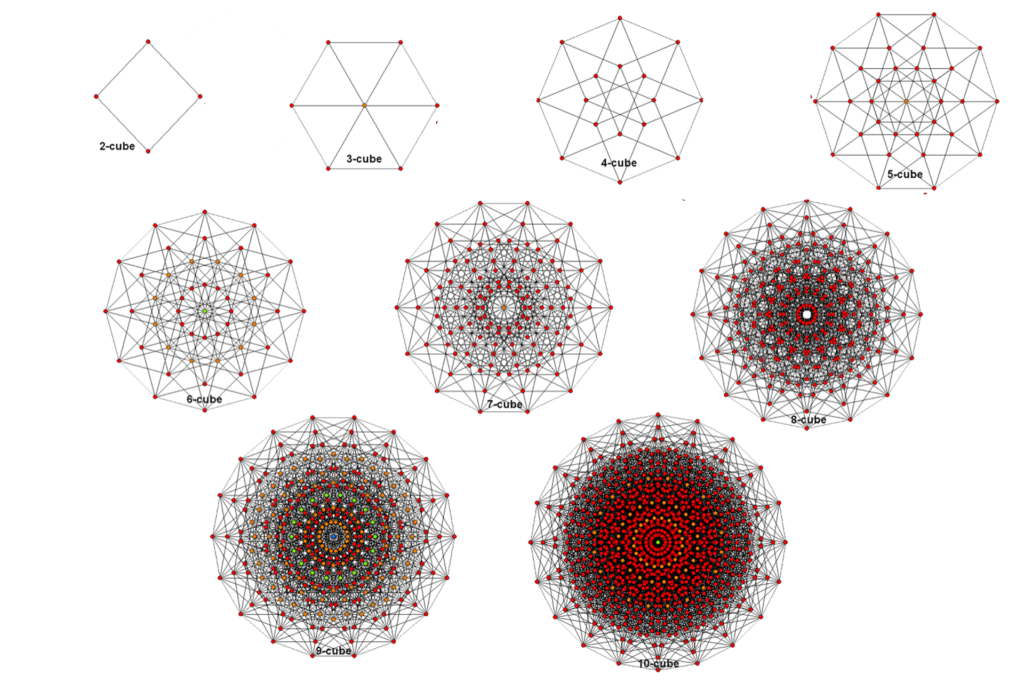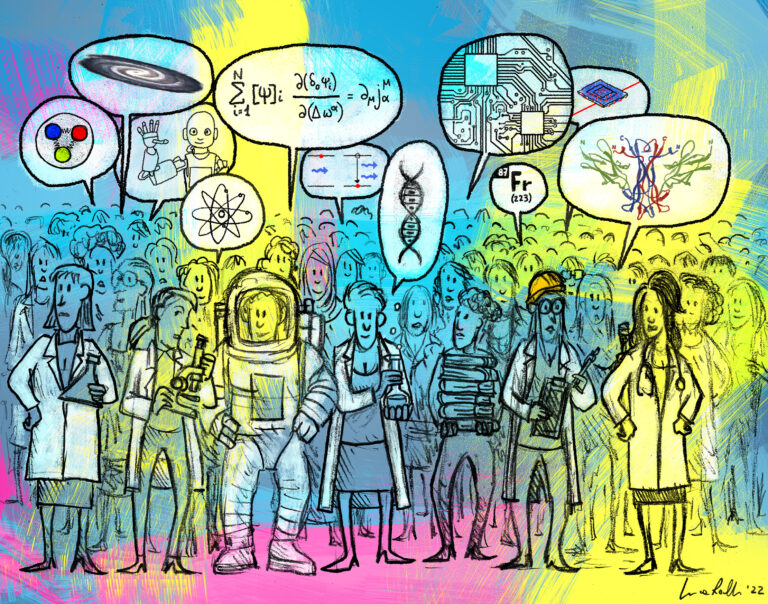“…if I am recalling an incident very vividly I go back to the instant of its occurrence: […] I jump back for a moment. Of course we have no means of staying back for any length of Time, any more than a savage or an animal has of staying six feet above the ground. But a civilised man […] can go up against gravitation in a balloon, and why should he not hope that ultimately he may be able to stop or accelerate his drift along the Time-Dimension, or even turn about and travel the other way?”
[H.G. Wells, The Time Machine]
If, for Calvino, the four-dimensional universe is the perfect theatre for the Cosmicomics (see Wrong geometries), a few decades before him, H.G. Wells thrust himself into the realm of science fiction, imagining a universe freely navigable in time as in space. Thus, the traveller of “The Time Machine” can explore the temporal dimension thanks to the invention of a vehicle that can carry him into the future. After several incursions into the future, and as many returns to the present, the search for a time in which humanity is not yet extinct and the problems and enigmas that worry it are resolved, will push the traveller – the book’s ending leads us to believe – to take the time machine again and wander about the future, never returning.
Wells published the novel in 1895. Albert Einstein’s theory of General Relativity had not yet been conceived, nor the idea that we now accept as irrefutable (even if not exactly intuitive) of a four-dimensional universe, in which the three spatial dimensions intersect with the fourth: time. More than 100 years after the formulation of General Relativity, four-dimensional spacetime is the undisputed, consistent backdrop to cosmic events described by physicists and astrophysicists. The surprising aspect is that the intuition that time is entirely similar to the three dimensions of space belonged to H.G. Wells, a science-fiction writer, before Einstein.
TIME TRAVEL
In the second half of the 19th century, the question about the nature of time was particularly current, emerging thanks to the very fast technological and industrial development under way, which accelerated the rhythm of life for people, cut short travel times, and sped up communications. Even the use of increasingly sensitive measuring instruments for scientific investigation contributed to making time a more tangible reality that could be explored. To convince his friends that time is just a “kind of Space”, and must, therefore, be navigable both forwards and backwards with the same ease, Wells’s traveller describes the example of the temporal change in a physical quantity, atmospheric pressure:
“Scientific people […] know very well that Time is only a kind of Space. Here is a popular scientific diagram, a weather record. This line I trace with my finger shows the movement of the barometer […] Surely the mercury did not trace this line in any of the dimensions of Space […] [b]ut certainly it traced such a line, and that line, therefore, we must conclude, was along the Time-Dimension.”
[H.G. Wells, The Time Machine]
It wasn’t only trains and barometers that suggested the reality of the temporal dimension to Wells. The 19th century is also the century of Darwin and of the theoretical and experimental reconstruction of the history of the Earth and of life through the study of geological stratifications and fossils – a kind of frozen image of changes in the same environment over time – and the application of archaeology to the cultural-historical composition. This study led us to change temporal scale, to depart from our daily dimension to observe the evolution of the Earth along whole millennia.
THE FOURTH DIMENSION
What does the idea that time has the same dignity as space imply? It means imagining a new, four-dimensional space: spacetime, in which the position no longer indicates a point but an event (the “here and now”). Imagining a four-dimensional reality is impossible for those of us immersed in three dimensions: just as the character of a comic is trapped in the two dimensions of the paper’s surface, our perception cannot go beyond the three dimensions of space.
But, as Wells does when he interprets the changes in a barometer’s mercury as a movement along the temporal dimension, we can translate any object along the line of time. Let’s think, for example, of the parallelepiped that is obtained by piling photographs of the same object taken in successive moments: the dimension that gradually increases is precisely the temporal line along which the evolution of the image moves.
It’s more difficult, if not impossible, to imagine the geometric shape that is obtained by “moving” a three-dimensional object through time. The solid that mathematicians have devised by adding dimensions to the three dimensions of the cube is the hypercube, a geometric shape that, in four dimensions, takes the name of tesseract and that we can describe thanks to its 16 vertices, 32 corners, 24 square faces, and 8 three-dimensional cubic faces. We know that 4 corners, 6 square faces, and 4 cubic faces hit each vertex of the tesseract. In short, we know everything about the tesseract, except for its precise image.
STARLIGHT
Let’s abandon the abstract tesseract for a moment and imagine that the celestial objects: the earth, the planets, the stars, and the galaxies, are flat, two-dimensional, and the universe is a cylinder – or a cone, taking into account its expansion – in the two dimensions of flat space and along time. Like a frozen river whose every moment we can describe by dissecting its shape at the time that interests us, the universe seen in this way does not change over time because time is part of it, as the dimensions of space are part of it: it is a continuum that contains everything that has happened and everything that will happen.
This representation does not coincide with Einstein’s, which we now accept. General Relativity offers us a less rigid image of the universe: a spacetime curved by gravity, in which the mass of bodies dictates law, including the law governing causal connections between events (see A matter of mass ). In Wells’s simplified representation, in any case, we can get an idea of what time travel is. Imagining a traveller who crosses the frozen universe is like observing the light of a star. Light travels at the fastest possible speed, yet always at a finite speed. Once it has reached the Earth, after hundreds of thousands of years, that light could be the last testimony of a celestial body that no longer exists, extinct for thousands of years. Light’s journey is not, then, only a journey through space: it is also a journey through time that carries the image of a distant past to our present.
THE WITNESS
If the universe imagined by Wells seems navigable, as a rule, along its temporal dimension, in all respects indistinguishable from the three spatial dimensions, our subjective perception of time is something quite different. One author capable of making the weight of time that flows, and its inevitability, palpable is Dino Buzzati. Let’s pass the torch to him, then, assigning Buzzati the task of representing, with his suspended narrative, the weight and the measure of time that, in expectation of an unattainable goal, can be said to be infinite.
“I began the journey not much older than 30 and more than eight years have passed […]. I thought, on leaving, that in just a few weeks I would easily have reached the boundaries of the kingdom. Instead, I kept meeting new people and countries; and, everywhere, men who spoke my language, who said they were my subjects. Sometimes I think my geographer’s compass has gone crazy and that, thinking we’re always going south, in actual fact, we perhaps went wandering around in circles, without ever increasing the distance separating us from the capital; this could explain why we still haven’t reached the last frontier.”
[Dino Buzzati, I sette messaggeri (The seven Messengers)]
The novel “The Time Machine” by H.G. Wells was, in Maria Giulia Scarcella’s reading, part of the event organised by INFN: “Einstein aveva ragione. Di cosa parliamo quando parliamo di onde gravitazionali [Einstein was right. What are we talking about when we talk about gravitational waves]”. The physicists Fernando Ferroni, Antonio Masiero, Fulvio Ricci, and Viviana Fafone featured in the event. Led by Marco Cattaneo, it was held in Rome, at the Auditorium Parco della Musica, on 18 February 2016, one week after the announcement of the discovery of gravitational waves by the LIGO and VIRGO collaborations.



